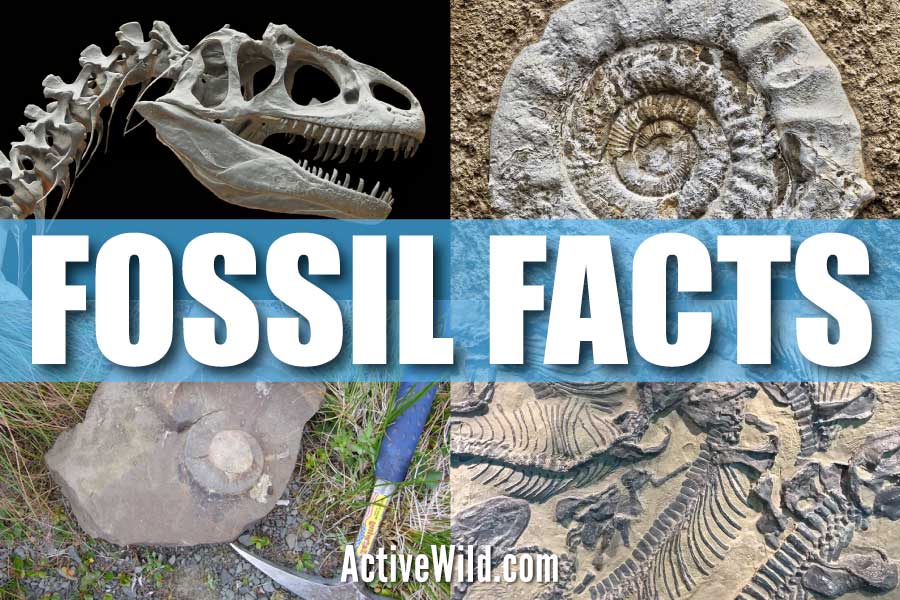Fossil facts: what is a fossil, how fossils form, the different types of fossils, and why fossils are important.
Page Index
- What Is A Fossil?
- Paleontologists
- The Fossil Record
- What Are The Oldest Fossils?
- Types Of Fossils
- Microfossils
- How Fossils Form
- Fossils In Tar And Resin
- The Geologic Time Scale
- Question Time
- Index Fossils
- Body Fossils
- Mold And Cast Fossils
- Trace Fossils
- Why Are Fossils Important?
- Where To Find Fossils
- Related Pages
What Is A Fossil?
A fossil is the remains of a living thing that has been buried and preserved in rock. A fossil can be the whole of an organism, part of an organism, or evidence of an organism’s existence, for example, its footprints or the burrow in which it lived. Fossils range in age from 10,000 to 3.48 billion years old, and in size from 0.001mm to as big as a dinosaur.
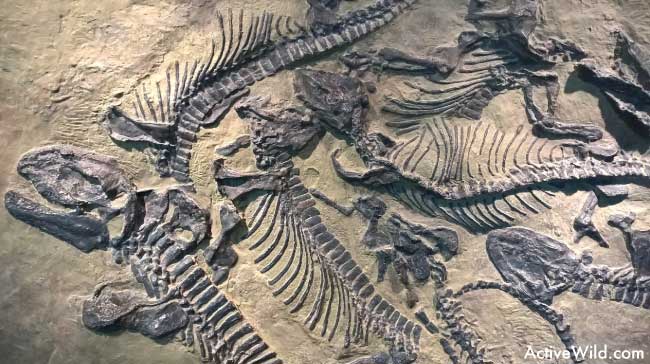
Fossil Fact: The word “fossil” is derived from the Latin word fossilis, which means “dug up”.
Paleontologists

Fossils are of particular interest to paleontologists: scientists who study prehistoric life. This branch of science is known as paleontology.
Fossils enable paleontologists to “look back in time” and study animals and plants that existed millions of years ago.
From fossils, paleontologists can tell not just what prehistoric animals looked like, but also how they moved, how they behaved, what they ate, and how they interacted with other living things.
The Fossil Record
The fossil record is a term used for all of the fossils that have ever been found. Using the fossil record, paleontologists can piece together when species appeared, when they became extinct, and how they evolved into other species.
Fossil Fact: The fossil record is by no means complete. Each new fossil that is found helps to “fill in the gaps” and further our knowledge of prehistoric life.
What Are The Oldest Fossils?
The oldest fossils are thought to be 3.48 billion years old, but some may be even older: chemical fossils (the remains of life in chemical form) thought to be around 4.1 billion years old have been found in zircon crystals in Australia.
The newest fossils are around 10,000 years old.
Types Of Fossils
There are three main types of fossils: body fossils, trace fossils and chemical fossils.
- Body fossils are the fossilized remains of an animal or plant’s body (or, more usually, part of its body). You can find out more about body fossils below.
- Trace fossils contain evidence of a living thing’s existence, such as a dinosaur’s footprints, or the holes made by a prehistoric plant’s roots. Trace fossils do not contain any of the organism’s body. You can find out more about trace fossils further down the page.
- Chemical fossils are chemicals, formed from living things, that are found in rocks. Chemical fossils can provide evidence of very early life.
Microfossils
Microfossils are fossils that can only be studied with the aid of a microscope. They are usually between 0.001mm and 1 mm in size.
Micropaleontology is a branch of paleontology concerned with the study of microfossils.
How Fossils Form
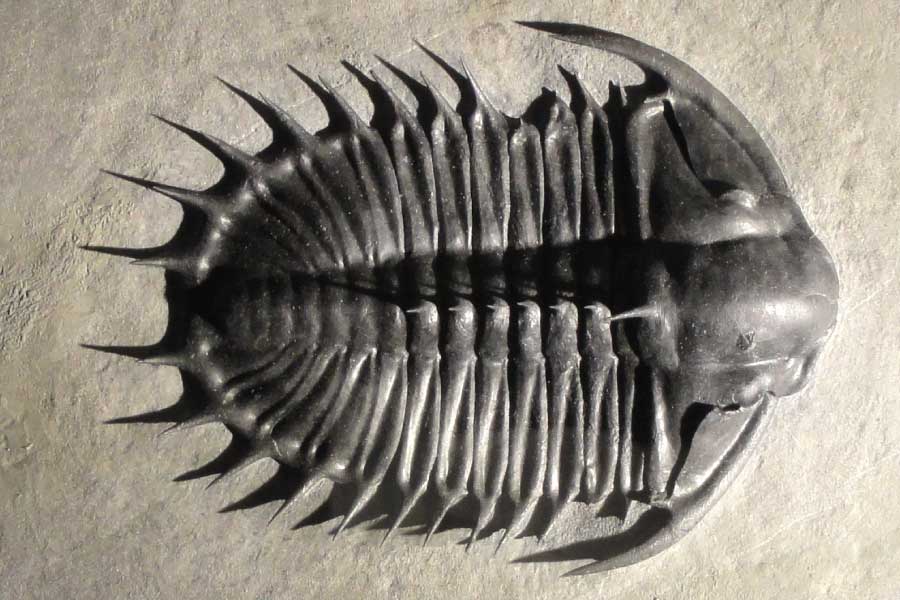
Fossilization
The process by which an organism becomes a fossil is known as “fossilization”.
Fossilization usually involves minerals in the organism’s body being replaced by other minerals, forming a rock version of the original organism.
Usually, an organism’s body is gradually broken down into basic chemicals until nothing of the organism’s original form remains. This process is known as decomposition and is aided by decomposers: organisms such as bacteria and fungi.
Most organisms decay in this way. It takes a rare set of circumstances for a fossil to be formed.
Fossil Fact: Fossilization is a very rare occurrence; scientists estimate that only one out of a million dead organisms has a chance of turning into a fossil. Even then, it is likely that the fossil will never be found.
The soft tissue of an organism, such as animal’s skin and organs, are the first parts to decay. Hard parts, such as bones, teeth and claws, take much longer to decay, and are more likely to become fossilized. In plants, it is most often the leaves that are fossilized.
Areas in which decomposers are less likely to occur, such as those with low oxygen levels, or low temperatures, are more likely to produce fossils in greater quantities and with greater detail.
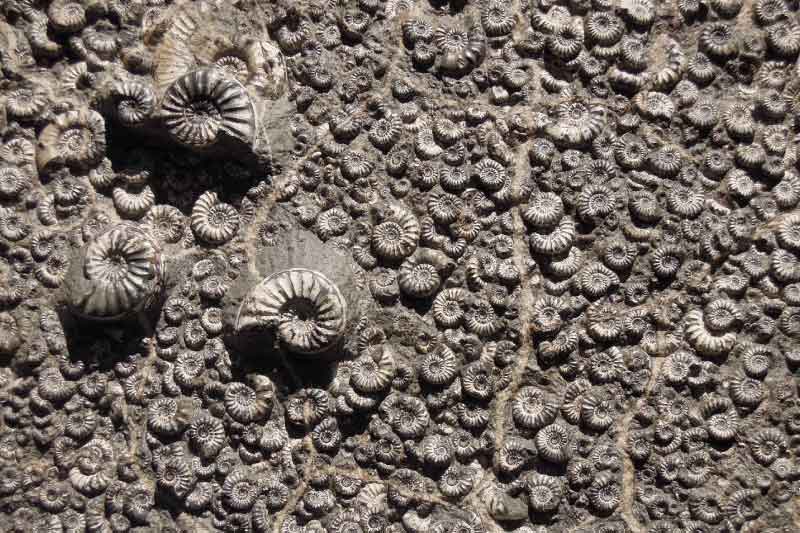
Fossils form in many different ways. The steps below outline the most common process by which the body parts of a plant or animal gradually turn into rock.
- The organism becomes buried by sediment such as sand, silt or mud. This happens most easily in wet and watery environments, which explains why fossils are often formed at the bottom of oceans, lakes and rivers.
- Organic molecules from the organism’s remains are replaced by minerals carried by the water present in the surrounding sediment.
- The fossil forms when these minerals crystallize and become solid rock. The most common mineral crystals to form fossils are calcite (containing calcium carbonate), silicate (containing silicon dioxide) and phosphate (containing phosphorus).
- Sediments continue to be deposited in layers over the fossil. For example, a river may flood into a lake every year when the rains come, causing a new layer of silt to settle on the bottom.
- As the sediments pile up over time, they compress the layers below. Gradually this pressure becomes great enough to make the sediments fuse together and become sedimentary rock.
Fossil Fact: Fossil bones and teeth are found in a variety of colors, even though the original tissues were all white. The colors come from the minerals that seeped into the tissue and crystallized. Some phosphates are jet black; red or orange fossils indicate minerals containing iron; calcite produces gray-green fossils.
Fossils In Tar And Resin
Fossils can also form in natural preservatives such as tar or resin.
Fossils In Tar Pits

Tar pits are areas in which oil is forced to the surface, forming pools of asphalt – a dark, sticky substance in which animals can become trapped. The tar pit’s victims sink into the asphalt, which preserves their bodies.
La Brea Tar Pits, in southern California, is one of the best-known tar pit fossil sites. Here, fossils of many animals, including mammoths, saber-toothed cats, dire wolves and American lions, have been found.
Fossils In Resin

Animals and plants can be naturally preserved in resin. Resin is a sticky, protective substance secreted by trees. Small animals (such as insects) and plants can become trapped in resin, which hardens over time and eventually fossilizes to form amber.
There are numerous examples of insects and spiders preserved in amber. Occasionally, frogs and lizards have also been preserved this way. The oldest fossil in amber is 230 million years old.
The fictional dinosaurs in the film Jurassic Park were brought “back to life” from dinosaur blood collected from mosquitoes that had become encased in amber.
Other Fossil-Producing Environments
In very cold regions plants and animals do not decay because bacteria and fungi cannot survive in these conditions. In 2013, scientists in Siberia retrieved a whole mammoth that had been frozen for 40,000 years.
Animals or plants that fall into peat bogs can also be well preserved. Peat bogs are acidic and have low oxygen levels, making them unfriendly places for decomposers. In 2016, scientists found remnants of a dinosaur brain that had been preserved and mineralized in a peat bog in England. The dinosaur had died 133 million years ago.
Bacteria and fungi cannot survive In very arid conditions such as deserts. Dead plants and animals in this environment may simply dry out or mummify when dead. A mummified leaf from a tree in a 23-million-year-old forest in New Zealand has helped researchers understand how trees adapted to higher levels of CO2 in those ancient times.
The Geologic Time Scale
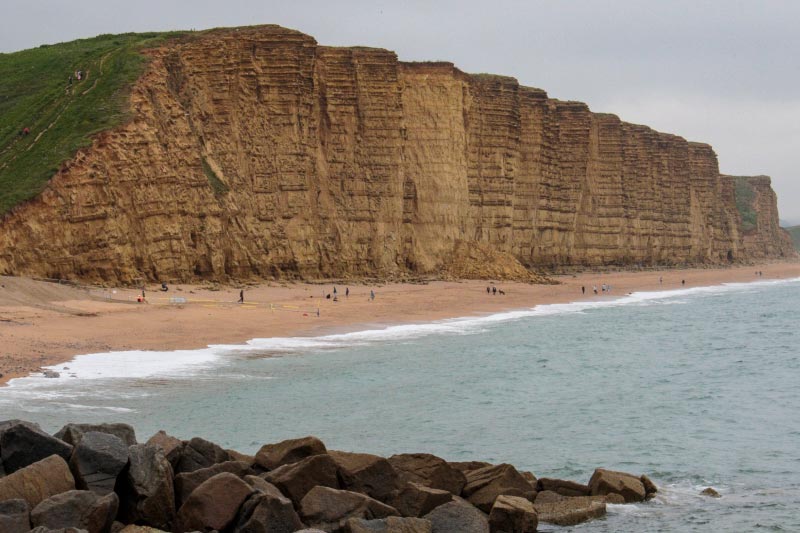
Scientists such as paleontologists and geologists (scientists who study rocks) often talk about time not in terms of years or decades, but in terms of eras, periods, and other units of the geologic time scale.
The geologic time scale is a way of measuring time using layers of rock as a reference.
Rock is formed in layers, and different layers of rock are formed at different points in time. The oldest layers are the deepest, with each newer layer of rock forming over the previous layer.
Fossils are usually the same age as the rock in which they are found. Therefore, fossils found in the Cretaceous layer of rock come from animals and plants that lived during the Cretaceous Period.
Using the geologic time scale, paleontologists can tell when a particular fossil lived – and when it became extinct. If a particular fossil is abundant in one rock layer, but missing from the next layer, then it likely means that the species became extinct at that time.
Question Time
Fossils of one major group of large land animals are present in Cretaceous rocks but are missing from Paleogene rocks – do you know what type of animals they were?
- See this page for the answer: Cretaceous-Paleogene Extinction Event
Index Fossils
An index fossil is a fossil of an organism that is known to have been common and widespread in a particular period. The presence of that fossil can then be used to date other rock formations and fossils.
For example, Dactylioceras, a genus of ammonite, existed in large numbers around 180 million years ago, during the early Jurassic Period. If Dactylioceras is present in a rock formation, then that rock formation is likely to have been formed in the early Jurassic – and any other fossils found in that formation would also likely have lived in that period.
Fossil Fact: Because ammonites were so abundant, they are often used as index fossils.
Body Fossils
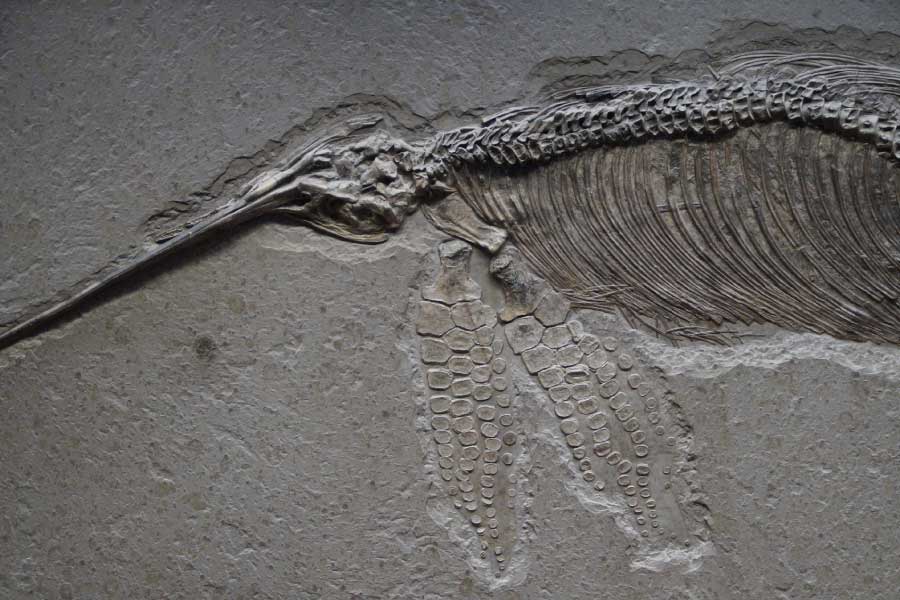
From the spiral shell of an ammonite to the skeletal remains of a T. Rex, body fossils are the most familiar type of fossil.
Body fossils are formed when either the whole or part of an organism’s body are preserved.
Mold And Cast Fossils
Body fossils usually form after being covered in sediment, compressed and mineralized. Fossils formed in this way fall into two categories: mold fossils and cast fossils.
A mold fossil is formed when the remains of an organism, such as a seashell, become encased in sedimentary rock but are then slowly dissolved away leaving a shell-shaped hollow in the rock. Mold fossils are thus imprints of an organism’s remains.
A cast fossil forms in the same manner, but goes through one more step. The hollow imprint becomes filled with sediment or with minerals that crystallize and harden. Thus, a cast fossil represents the shape of the organism’s remains rather than an imprint.
Trilobites and ammonites are regularly found as mold and cast fossils.
Fossil Fact: Mold and cast fossils usually contain nothing of the original animal or plant remains. Those have been dissolved away by water. So, when a paleontologist finds dinosaur bones there is no actual bone present. What is excavated out of the ground is rock that has formed in the shape and place of the bone.
Trace Fossils
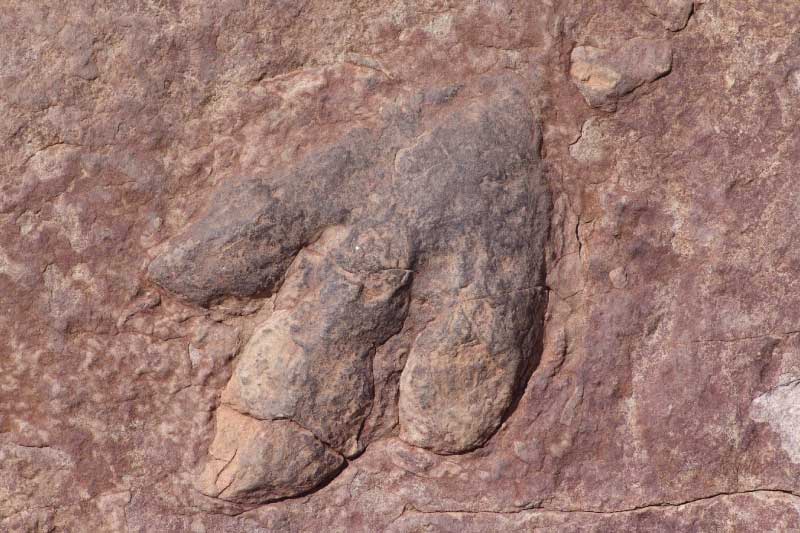
Trace fossils record the presence or activity of an organism without preserving any part of its body. Footprints are an example of trace fossils, as are burrows, nests, tooth marks and dung.
Fossil Fact: The fossilized dung of an animal is known as a coprolite.
The Connecticut River trackways show the fossilized footprints of early Jurassic dinosaurs that walked across a muddy surface about 200 million years ago. These trace fossils are the first evidence of dinosaur being present in North America.
Why Are Fossils Important?
Fossils provide us with evidence of life that existed long before humans appeared. Using fossils, we can piece together how and when living things first appeared, how they evolved, and when they became extinct.
The fossil record is one of the major sources of evidence supporting the theory of evolution.
We can also use fossils to find out more about Earth; for example, how the continents and oceans have moved, and how the climate has repeatedly warmed and cooled over Earth’s lifetime.
Fossils of Cretaceous marine animals such as plesiosaurs, mosasaurs, sharks, and ammonites found in the interior of North America tell us that the continent was once divided by sea. The sea, which existed from the mid-Cretaceous to the early Paleogene Periods, is known as the Western Interior Seaway.
The earth’s crust moves as continents shift, tectonic plates crash into one another and mountains rise. In this way the beds of oceans, lakes and seas can be lifted up and transformed into mountains. This explains why fossils of ammonites and marine fish have been found in the Himalayan mountains, thousands of miles from the sea.
Where To Find Fossils
Most fossils are found in sedimentary rock such as limestone, shale and sandstone. Good places to find fossils are outcrops or cliffs where ancient, fossil-rich sedimentary bedrock has been exposed. Man-made cuttings and quarries are also good places to look for fossils because here too the older rocks can be exposed.
Related Pages
Discover more with Active Wild:
- Prehistoric Animals Book List: The Best Books On Prehistoric Life
- Trilobite Facts: Amazing Animals That Existed Millions Of Years Before The Dinosaurs
- Ammonite Facts: Discover An Amazing Prehistoric Ocean Animal
- The Triassic Period Facts For Kids & Adults: The Ultimate Guide to the First Period of the Mesozoic Era.
- The Jurassic Period Facts: The Ultimate Guide To The Second Period Of The Mesozoic Era
- The Cretaceous Period Facts: The Ultimate Guide To The Third & Final Period Of The Mesozoic Era

